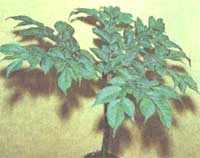Amorphophallus / Amorphophallus
Refers to the family of aroids. The homeland of the tropics of Africa and Asia.
General description : Ornamental flowering tuberous plant. Quite a bit common, perhaps because of the unwanted smell of flowers. It is quite unpretentious, hurrying up. For the winter he drops leaves. Blooms in the spring, until the appearance of leaves. Inflorescence on the long peduncle in the form of an ear.
The most common pair of species: Amorphophallus konjac (Amorphophallus cognac) and Amorphophallus bulbifer (Amorphophallus bulkotsenosny). Amorphophallus cognac is a large plant with pinnately dissected leaves. Flowers are red-violet or burgundy. Amorphophallus bulkotsenosny possesses only one spotted leaf on the long petiole. Flowers are green with pink spots.
Recommendations for caring for the plant Amorphophallus:
Illumination: Photophilous, but in no way tolerates direct sunlight.
Irrigation regime: During the growth period, it needs abundant watering. In winter, at what time the plant will discard leaves, water it is not necessary.
Humidity : Periodic spraying is desirable.
Temperature regime: In summer, the temperature should be moderate, in the winter cool, if the tuber is not taken out of the pot.
Soil: Recommended soil mishmash: 1 share of clay-sod land, 1 share of leaf land, 1 share of humus, 1 share of peat and 1 share of sand. During the growth period, it needs regular fertilizing with complex fertilizers with an impressive intake of phosphorus. Well responds to feeding organic.
Breeding : Later, as if the plant had thrown off the leaves, the daughter tubers that are planted in the spring are separated.
Transplantation: In winter, tubers are usually removed from the ground, disinfected in manganese, dried and stored in dry and warm conditions. In March, put in nutritious soil. The plant hastily moves into growth.
Pests: It is infrequent.

Amorphophallus - Amorphophallus


Comments
When commenting on, remember that the content and tone of your message can hurt the feelings of real people, show respect and tolerance to your interlocutors even if you do not share their opinion, your behavior in the conditions of freedom of expression and anonymity provided by the Internet, changes Not only virtual, but also the real world. All comments are hidden from the index, spam is controlled.